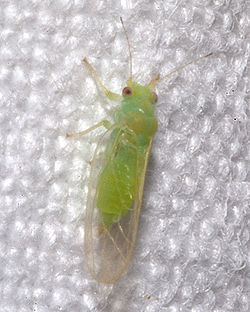| Psylla | |
|---|---|
 | |
| Psylla alni | |
| Scientific classification | |
| Kingdom: | Animalia |
| Phylum: | Arthropoda |
| Class: | Insecta |
| Order: | Hemiptera |
| Suborder: | Sternorrhyncha |
| Family: | Psyllidae |
| Subfamily: | Psyllinae |
| Genus: | Psylla Geoffroy, 1762 |
| Diversity | |
| at least 110 species | |
| Synonyms [1] | |
| |


Psylla (from the Greek psulla, meaning flea) is the type genus of sap-sucking insects in the family Psyllidae. There are at least 110 described species in Psylla. [2] [3] [4] Species within the genus feed on various host plants.
Contents
Some agricultural pests, previously placed here, are now in related genera, such as Cacopsylla (which includes at least two species harmful to fruit trees); other revised species names include the "Albizia fly" ( Acizzia jamatonica, in the same family) and the laurel fly ( Trioza alacris in the family Triozidae).